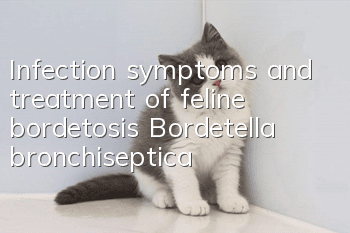Infection symptoms and treatment of feline bordetosis (Bordetella bronchiseptica)

Bordetosis in dogs and cats, also known as Bordetella bronchiseptica, is one of the bacteria that is pathogenic to dogs and cats.
Pathogenic bacteria that belong to the same genus as Bordetella include Bordetella avium, Bordetella pertussis, and Bordetella parapertussis. The latter two are obligate pathogenic bacteria for humans, while septicaemia bacilli can also cause infection in humans and has a high fatality rate in young dogs and cats.
Infection symptoms are divided into rhinitis type, bronchopneumonia type and septicemia type. Rhinitis is the most common type, with serous or mucopurulent secretions coming out of the nasal cavity of affected dogs and cats. Bronchopneumonia is mostly sporadic, and sick dogs and cats sometimes have white mucus-purulent secretions from their nasal cavities. In the later stages of the disease, they have difficulty breathing, assume a dog-sitting posture, lose their appetite, become emaciated, and die. The septicemia type is caused by bacteria invading the blood and causing death quickly if not treated.
Syndrome of the disease includes fever, cough, sneezing, eye discharge and peripheral lymphadenopathy.
Symptoms of pneumonia more commonly appear in dogs and cats under 10 weeks of age.
Bordetella bronchiseptica is a small Gram-negative bacterium. It forms small round, raised, smooth and moist colonies 24 hours after culture with MacConkey. On glucose neutral red agar plates, colonies are medium in size and appear transparent smoky gray. The broth culture solution has a pythium smell. Beta hemolysis occurs on blood agar. It does not ferment sugars and can utilize citrate and decompose urea.
Gram staining under the microscope shows small bacilli with blunt rounded ends, occasionally in pairs. Silver nitrate staining showed 3-5 flagella, ink staining showed no capsule, and Schiff staining showed no spores.
This pathogenic bacteria (Bordetella bronchiseptica) is very widespread in animals and can cause diseases in various mammals from marsupials to ungulates, rodents and carnivores, such as : Rhinitis, pneumonia, canine infectious tracheitis, bronchitis and simple bronchial septicemia, etc.
Humans may be infected from a rabbit, cat or other mammal, and in some cases of pediatric infected lung transplant recipients, dogs are suspected to be the origin of infection; and in some humans who are infected due to low immunity In the case, cats are also suspected as the source of infection, so this is a zoonotic disease.
Dogs and cats can also be infected from humans or the various animals and environments mentioned above.
This bacterium often exists on the upper respiratory tract mucosa of cats. For cats, this is a common bacterium in the cat’s respiratory tract. When cats suffer from various conditions secondary to mood, environment, innate immunity, etc., or other respiratory infections, they will be infected with this bacteria and have the opportunity to External communication.
Because this bacterium belongs to Bordetella, multiple factors are required to initiate infection, colonization and reproduction in the host respiratory tract: adhesins (filamentous hemagglutinin, permeability and agglutinin) and toxins (Pertussis toxin, tracheal cytotoxin, and adenylyl cyclase-hemolysin); Bordetella, considered an extracellular bacterium, can actually survive within host cells; Expression of bortella virulence factors during infection Changes may occur that allow the bacteria to escape the host's immune response.
As with feline calicivirus and feline herpesvirus, overcrowding and mismanagement can lead to infection and disease.
And this disease is often secondary to infection by these two viruses.
Bordetella bronchiseptica is widely spread, with more chronic cases and less acute septicemia deaths. It spreads through the respiratory tract. The germs in the nasal secretions of infected dogs and cats and sick dogs and cats can contaminate feed, drinking water, cages and air through coughing and sneezing droplets, and can infect healthy animals or humans.
In a survey of a sample (740 cats), it was isolated from 19% of traffic cats and from 13.5% of suspected cases.
For treatment: Antimicrobial treatment is necessary. Even if the symptoms are mild, the bacteria may progress to the lower respiratory tract and cause pneumonia or sepsis.
About drug sensitivity:
In a study of 42 canine/feline Bordetella bronchiseptica strains, a significant number of strains proved to be resistant to some bacterial agents or exhibited high MIC values, in the absence of susceptibility. data, the use of tetracycline is recommended because most feline Bb strains have been found to be susceptible to infection. Doxycycline is the antibacterial drug of choice. Feline Bacteria are less susceptible to clavulanic acid-enhanced amoxicillin, and resistance to ampicillin and trimethoprim is frequently found (Speakman et al.).
After several years of development, this bacterium has developed more types, with different drug resistances. Therefore, drug susceptibility tests and PCR checks are necessary.
In some respiratory tracts, or when other pathogens have been identified and do not improve significantly after treatment, infection caused by this bacterium needs to be considered.
For this kind of bacteria, PCR examination is better than bacterial culture.
- Do stray cats eat cat food?
- Are cats cold tolerant?
- Can healthy cats eat meat?
- American Shorthair Kitten Failed Appearance
- Black dots growing between cat’s toes
- Can I shave my cat to cool down in summer? Under what circumstances can a cat be shaved?
- What should I do if my cat is not in good spirits and not as active as before?
- At what age do cats need to be vaccinated?
- How to treat pica in cats
- Can pet cats eat fried meat?



